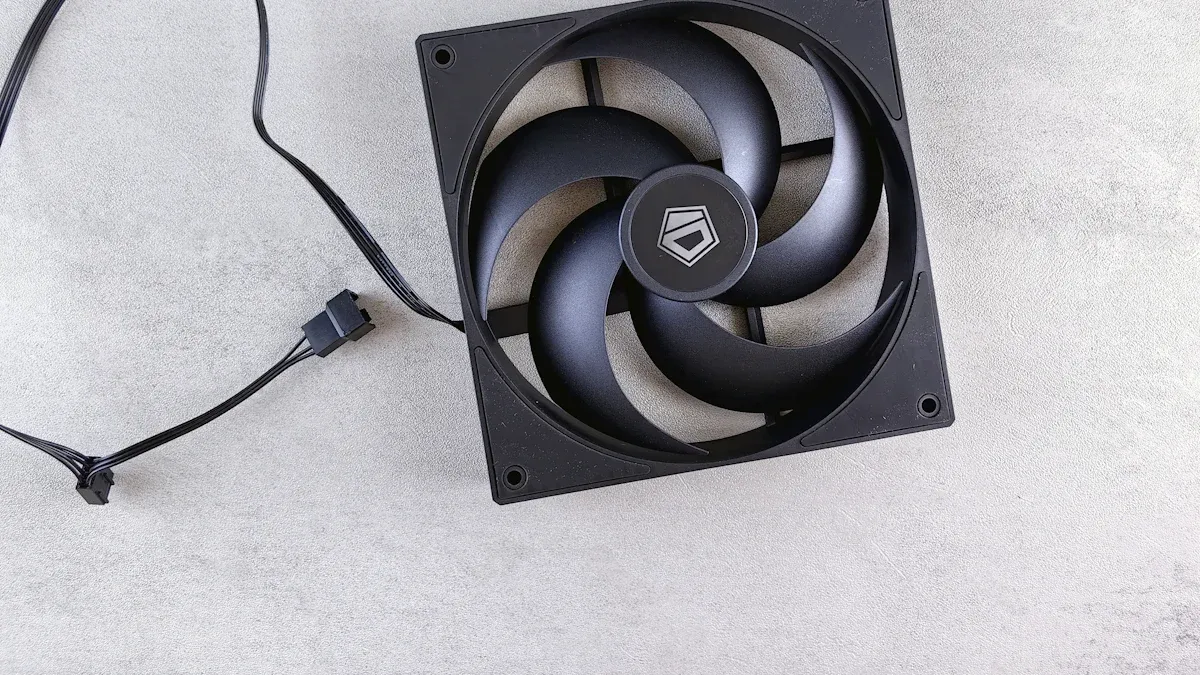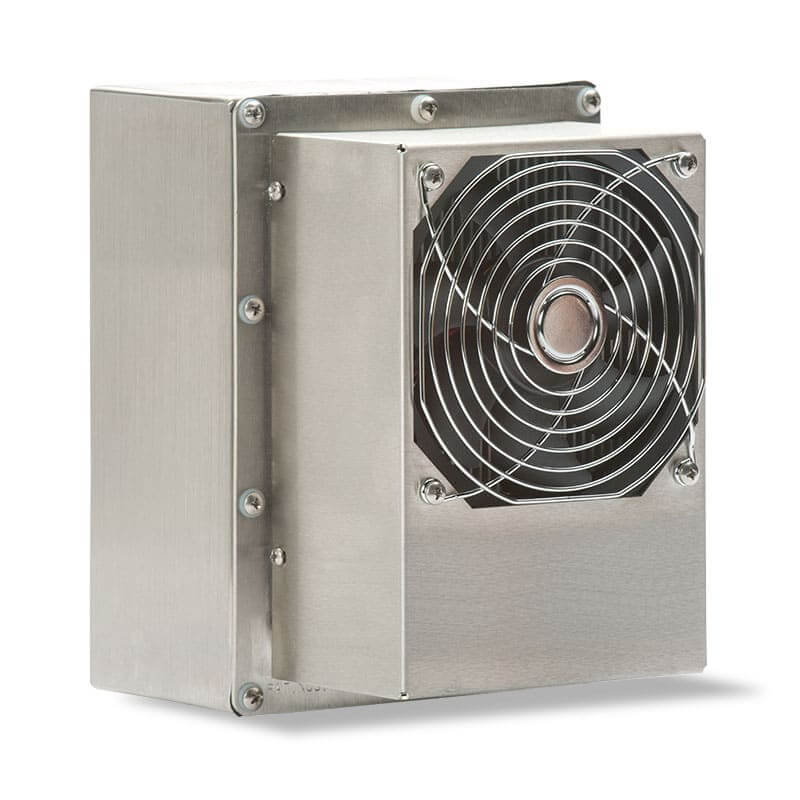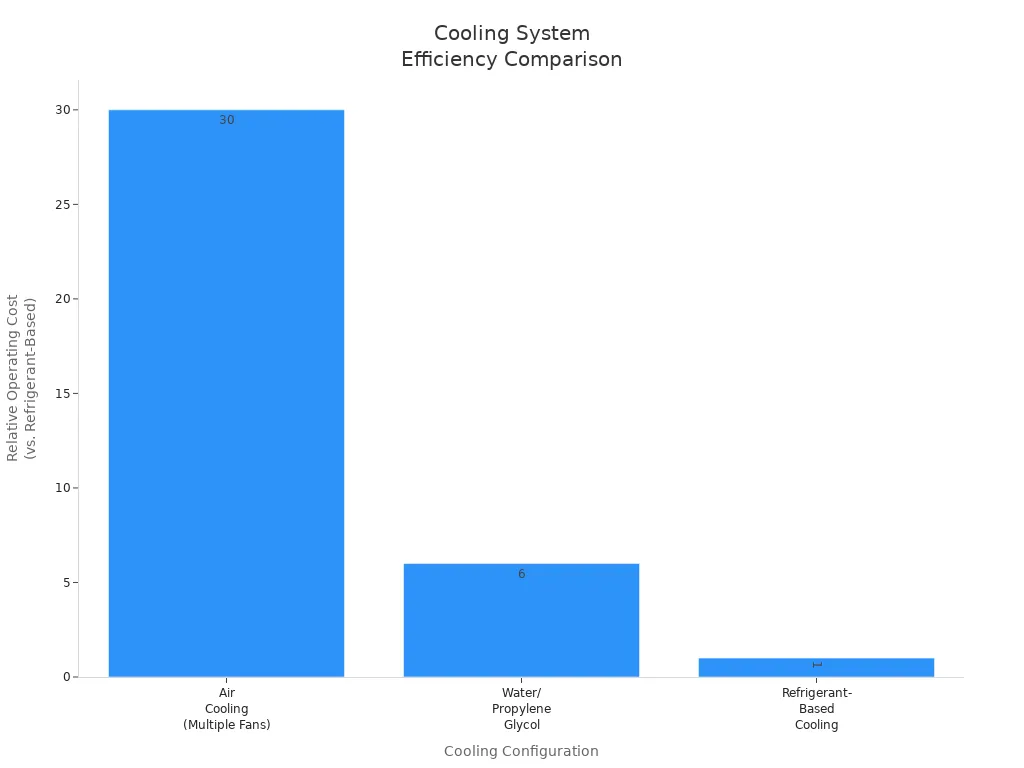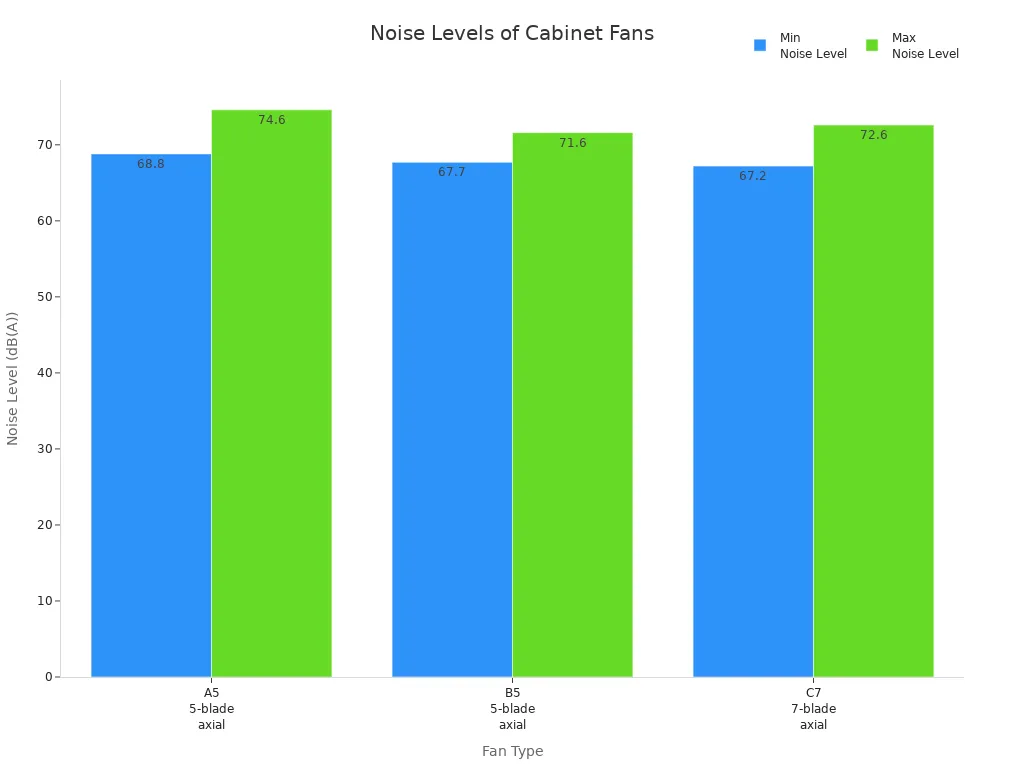What should you look for when choosing a cabinet fan for telecom cabinets

Selecting the right cabinet fan for telecom cabinet demands attention to key factors: airflow, cooling capacity, compatibility, energy efficiency, noise, and reliability. You must match the cabinet fan to your telecommunication cabinet’s size, heat load, and cooling system. Effective cooling prevents excess heat and supports stable telecommunication performance. Quality installation and trusted brands like ESTEL ensure lasting cooling system efficiency and cabinet fan performance.
💡 Tip: A well-chosen fan boosts cooling capacity, manages heat, and extends telecommunication equipment life.
Key Takeaways
Choose a cabinet fan that matches your telecom cabinet’s size, heat load, and cooling needs to prevent overheating and protect your equipment.
Understand the differences between axial and centrifugal fans, and select based on airflow volume, pressure needs, and whether your system uses ductwork.
Calculate the required airflow by adding internal and external heat loads, then apply a safety factor to ensure reliable cooling performance.
Consider noise levels and energy efficiency when selecting fans to reduce operational costs and maintain a comfortable working environment.
Regular maintenance, including cleaning filters and inspecting fans, keeps your cooling system efficient and extends the life of your equipment.
Cooling Needs in Telecommunication Cabinets
Importance of Proper Cooling
You must prioritize cooling in every telecommunication cabinet. Effective cooling ensures that sensitive electronics operate within safe temperature ranges. When you install the right cooling solutions, you protect your equipment from high heat loads and maintain stable performance. Outdoor enclosure cooling systems play a vital role in managing heat, especially in harsh environments. These systems keep the temperature between 18°C and 27°C, which is essential for preventing overheating and maintaining optimal cooling performance.
Proper cooling reduces the risk of hot spots and uneven temperature distribution. You can extend the lifespan of your telecommunication equipment by up to 50% with the right cooling system. Good airflow and ventilation help dissipate heat quickly, supporting reliable operation even under high heat loads. Outdoor enclosure cooling systems also regulate humidity and filter dust, which further protects your equipment from environmental threats. Regular maintenance, such as cleaning filters and inspecting fans, keeps your cooling system efficient and prevents heat buildup.
🛠️ Tip: Regularly check your cooling system for blockages or dust buildup. Clean filters and cooling fins to maintain strong airflow and consistent temperature control.
Risks of Overheating
Overheating poses serious risks to telecommunication cabinets. High heat can break down electronic components, leading to costly repairs and unexpected downtime. Even a 10°C rise in temperature can cut the lifespan of your equipment in half. High heat loads stress solder joints, capacitors, and integrated circuits, causing premature failure. Data loss and reduced processing power often result from thermal stress.
You may also face increased operational costs if you neglect cooling. Overheating can cause thermal throttling, which lowers system efficiency and performance. Outdoor enclosure cooling systems help you manage heat needs and prevent these issues. By preventing overheating, you reduce failure rates by 30%, extend battery life by 25%, and cut repair visits by 50%. Choosing the right cooling solutions for your telecommunication cabinets ensures reliable operation, even in environments with high heat loads and challenging conditions.
Types of Cabinet Fan for Telecom Cabinet

Axial vs. Centrifugal Fans
When you select a cabinet fan for your telecom cabinet, you must decide between axial and centrifugal fans. Each type offers unique airflow characteristics and performance benefits. Axial fans move air in a straight line, parallel to the fan’s axis. Centrifugal fans push air outward from the center, creating higher pressure.
The table below highlights the main differences:
Characteristic | Axial Fans | Centrifugal Fans |
|---|---|---|
Airflow Volume | Higher air volume, typically 100 to 500,000 ft³/min | Lower air volume, typically 500 to 125,000 ft³/min |
Operating Speed | Higher operating speed | Lower operating speed |
Airflow Direction | Air flows parallel to the fan axis | Air flows radially outward |
Air Pressure | Lower air pressure | Higher air pressure |
Efficiency with Ductwork | Less efficient with ductwork | More efficient with ductwork |
Maintenance | Requires periodic maintenance only | Offers self-cleaning ability |
You should choose axial fans if your telecom cabinet needs high airflow and minimal resistance. Centrifugal fans work best when your system requires higher pressure or uses ductwork. Both types of cabinet fan play a critical role in maintaining proper cooling and airflow.
💡 Tip: For cabinets with filters or ducting, centrifugal fans often provide better performance and reliability.
AC vs. DC Fans
You also need to consider the power source and efficiency when choosing a cabinet fan. AC and DC fans each offer distinct advantages for telecom cabinets. DC fans usually cost less upfront and consume less energy. You can save up to 80% on energy in moderate climates with DC fans. AC fans, especially those used in outdoor cabinet air conditioners, deliver precise temperature and humidity control. They protect sensitive equipment from dust and moisture.
Here is a comparison to help you decide:
Aspect | Cabinet Fans (DC) | Outdoor Cabinet Air Conditioners (AC) |
|---|---|---|
Initial Cost | Lower upfront cost | Higher upfront cost ($3,000 to $15,000+) |
Energy Consumption | Significantly lower; can save up to 80% energy in moderate climates | Higher energy use due to compressors and refrigerants |
Operational Cost | Generally lower due to energy efficiency | Higher due to energy use and maintenance |
Maintenance | Simpler design; easier and less costly | Requires regular professional maintenance |
Cooling Precision | Moderate; less precise temperature control | High precision temperature and humidity control |
Environmental Suitability | Best for mild, clean climates with low to moderate heat loads | Essential for harsh, hot, humid, or dusty environments |
Protection from Dust and Moisture | Limited; brings outside air into enclosure | Sealed system blocks dust and moisture ingress |
Longevity and Reliability | May wear out faster in harsh conditions | Longer equipment life by preventing overheating and moisture damage |
You should use DC fans for indoor or mild outdoor environments where energy efficiency matters most. AC fans suit harsh or demanding environments that require sealed protection and precise cooling. Always match your cabinet fan choice to your telecom cabinet’s specific needs and environment.
Airflow and Cooling System Selection

Calculating Airflow (CFM)
You must start by calculating the required airflow for your telecom cabinet. This step ensures your cooling system matches the heat generated by your equipment. Begin by identifying the internal heat load. Add up the power consumption of all devices and multiply by their operating time. This gives you the internal heat load (Q_i). Next, consider the external heat load. Calculate this by factoring in heat transfer through the cabinet walls and any solar heat gain, especially for outdoor enclosure cooling systems. Use the formula Q_r = (U × A × ΔT) + (SHG × A), where U is the heat transfer coefficient, A is the surface area, ΔT is the temperature difference, and SHG is the solar heat gain coefficient.
Add the internal and external heat loads to get the total heat load (Q_total). For reliability, apply a safety factor of 1.2 to this total. This accounts for unexpected increases in heat or changes in environmental conditions. Although you do not get a direct formula for airflow (CFM) from these calculations, these values guide your cooling system selection. You can then convert the total heat load into required airflow using cooling capacity and air properties.
Steps to Calculate Required Airflow:
List all equipment and their power consumption.
Multiply each by operating time to get internal heat load.
Calculate external heat load using cabinet surface area and environmental factors.
Add both to get total heat load.
Multiply by a safety factor (1.2).
Use this value to select a cooling system with adequate airflow and cooling capacity.
📝 Note: For complex setups, consider using Computational Fluid Dynamics (CFD) modeling. This helps you validate your calculations and optimize airflow management for your telecom cabinet.
Fan Placement and Direction
Proper fan placement is critical for effective cooling and ventilation. You need to identify the main sources of heat inside your cabinet. Place fans to direct airflow over these components. Monitor temperature at key points to guide adjustments in fan speed and position. This approach helps you achieve uniform cooling and prevents hot spots.
Environmental factors such as ambient temperature, humidity, and dust also affect airflow. In open loop cooling, filtered fans draw in outside air while blocking pollutants. This method works well when the ambient temperature is lower than the internal temperature. For closed loop cooling, use internal fans to circulate air within the sealed enclosure. This ensures heat moves efficiently to heat exchangers, which is vital for outdoor enclosure cooling systems.
You should also consider the natural movement of air. Hot air rises, so place heat-sensitive equipment like batteries at the bottom of the cabinet. This takes advantage of cooler air settling at the base. Avoid large temperature differences within the cabinet to maintain stable temperature zones. This strategy supports efficient cooling and extends equipment life.
To optimize airflow, maintain a front-to-back airflow pattern. Install fans at the front to draw in cool air and at the rear to expel hot air. This setup prevents airflow reversal and ensures consistent cooling. Seal any gaps and use barriers or chimney containment to guide airflow. Manage cables to avoid blocking ventilation paths.
💡 Tip: Regularly check fan direction and placement. Adjust as needed to improve airflow and cooling performance.
Fan Size and Mounting
Selecting the right fan size and mounting method is essential for matching your cooling system to the cabinet’s needs. Larger cabinets with more equipment generate more heat. These require stronger cooling systems, such as air conditioners or hybrid solutions. Smaller cabinets have limited space. In these cases, compact cooling methods like thermoelectric cooling or small fans work best.
How Fan Size Influences Cooling:
Larger cabinets need fans with higher cooling capacity to handle greater heat output.
Smaller cabinets require compact fans that fit tight spaces and still provide effective cooling.
Always match the fan to the cabinet’s layout, including vents, mounting points, and built-in features.
The effectiveness of a fan depends on matching its cooling capacity to the cabinet’s heat load and size.
The environment—indoor or outdoor—also affects which cooling system and fan size you should choose.
Properly matched systems prevent overheating and protect your equipment.
You must also consider mounting compatibility. Check the cabinet’s layout for available mounting patterns and space. Fans should fit securely and not interfere with other equipment or airflow paths. For outdoor enclosure cooling systems, ensure the fan and mounting method maintain environmental protection against dust and moisture.
Integrating fans into existing cabinets can present challenges. You may face space constraints, especially in densely packed cabinets. Make sure the fan does not compromise the cabinet’s security or environmental protection. Plan for regular maintenance, such as cleaning and inspection, to keep airflow strong and cooling performance high.
Cooling Configuration | Key Features | Efficiency / Operating Cost Comparison | Additional Notes |
|---|---|---|---|
Air Cooling (Multiple Fans) | Uses multiple high-pressure turbine-blade fans with rear-door heat exchangers; requires low ambient air temperature (~4°C) to maintain CPU case temp. | Least efficient; operating cost > 30 times that of refrigerant cooling | Does not meet acoustic noise standards; less feasible at high power densities (60 kW per cabinet) |
Water/Propylene Glycol Cooling | Multiple cold plates connected in parallel or series; requires pumps, manifolds, and regular coolant flushing due to corrosion and microbiological growth | Operating cost reduced by at least factor of 5 compared to air cooling | Requires complex piping and maintenance; flow velocity limits require parallel cold plate configuration |
Refrigerant-Based Cooling | Uses refrigerant with high heat of vaporization; fewer pumps needed; lower flow rates; options include rooftop condenser or refrigerant distribution unit | Most efficient; operating cost less than 1/30th of air cooling | Compact system; minimal maintenance; no microbiological or corrosion issues; best cost-effectiveness |

🚩 Alert: Always verify that your cooling system and fans are compatible with your cabinet’s size, layout, and environmental requirements. This step is crucial for selecting the right system and improving airflow.
Key Considerations for Cabinet Fan Selection
Noise and Energy Efficiency
When you select a cabinet fan, you must consider both noise and energy efficiency. These factors directly affect the operational cost and working environment of your telecom setup. Fan noise can disrupt nearby workspaces and contribute to long-term fatigue for technicians. Most axial fans used in telecom cabinets generate noise levels between 67 and 75 dB(A), depending on the model and installation. The following table compares typical noise levels for common fan types:
Fan Type | Noise Level Range (dB(A)) Across Cabinets |
|---|---|
A5 (5-blade axial fan) | 68.8 to 74.6 |
B5 (5-blade axial fan) | 67.7 to 71.6 |
C7 (7-blade axial fan) | 67.2 to 72.6 |

Noise mainly comes from blade passing frequency and airflow turbulence. If you push a fan beyond its pressure capacity, noise increases sharply. Radial or mixed flow fans often run quieter in high backpressure environments. You can reduce noise by optimizing fan placement and using sound-dampening cabinet materials.
Energy efficiency plays a crucial role in controlling operational expenses. Cabinet fans offer a low-cost cooling solution because of their minimal energy consumption. You can move large volumes of air efficiently, which helps manage heat without driving up electricity bills. For example, a 750 CFM fan with a 20°F temperature differential can remove as much heat as a small air conditioner, but it uses far less energy. Proper fan sizing and regular maintenance, such as filter cleaning, keep airflow strong and cooling performance high. This approach supports energy-saving designs and reduces your total cost of ownership.
💡 Tip: Choose fans with high energy efficiency ratings and low noise output to balance cooling needs and operational comfort.
Reliability and Maintenance
Reliability stands at the core of any telecom cooling strategy. You need fans that deliver consistent performance and withstand demanding conditions. High-quality brands like ESTEL set the standard for durability and environmental resilience. Their fans feature robust galvanized steel construction, double-wall designs, and advanced environmental protection such as IP55 ingress ratings. These features ensure your cooling system operates reliably in both indoor and outdoor environments.
Maintenance directly impacts both efficiency and lifespan. Well-maintained fans operate at 0.55 to 0.60 kW/ton, while neglected fans drop to 0.90 to 1.0 kW/ton, raising energy costs by up to 25%. You should follow a regular maintenance schedule to maximize cooling performance and minimize downtime. The table below outlines essential maintenance tasks and their impact:
Maintenance Task | Impact on Efficiency |
|---|---|
Cleaning and replacing filters | Significantly improves airflow and cooling efficiency |
Inspecting and cleaning coils | Significantly improves cooling performance |
Lubricating fan motors | Reduces friction and enhances fan operation |
You should also:
Inspect fan blades for dust and debris, cleaning them with a soft brush or compressed air.
Check fan motors for wear and lubricate them to reduce friction.
Clean or replace air filters to prevent overheating.
Ensure cabinet ventilation remains unobstructed.
Upgrade to active cooling systems in high-heat environments for better efficiency.
Active cooling solutions with smart monitoring can alert you before failures occur, reducing technician visits and minimizing downtime. This proactive approach keeps your telecommunication cabinet running smoothly and extends the operational life of your equipment.
🛠️ Note: Consistent maintenance not only improves efficiency but also protects your investment by extending fan and equipment lifespan.
Compatibility with Telecommunication Cabinet
Compatibility ensures your fan integrates seamlessly with your telecommunication cabinet. You must match fan thickness and mounting patterns to available cabinet space. Many modern cabinets, such as those from Signamax, use cage-nut standards and adjustable mounting flanges. These features allow you to fit fans and other equipment with different form factors. Pre-fabricated holes and fenders simplify fan installation and support a wide range of mounting patterns.
Cabinet size and configuration also affect compatibility. Iceberg Cabinets, for example, offer single-bay, dual-bay, and triple-bay options with integrated climate control. Flexible mounting and advanced cooling systems help you manage heat loads and maintain equipment longevity. Always check that your fan and mounting method do not interfere with other components or block airflow paths.
The material and construction of your cabinet play a significant role in cooling efficiency. High-quality cabinets use double-wall galvanized steel and welded structures for durability and thermal insulation. Environmental protection features, such as IP or NEMA ratings, ensure your cooling system withstands dust, moisture, and temperature extremes. The table below summarizes key industry standards:
Standard/Rating | Description | Relevance to Cabinet Fans in Telecom Cabinets |
|---|---|---|
NEMA Ratings | Protection against dust, water, corrosion | Ensures environmental protection and durability |
IP Ratings | Protection against solids and liquids | Guides selection for ingress protection |
NEBS Compliance | Withstands environmental stresses | Ensures reliability and safety |
ANSI/TIA 942-A | Data center redundancy and reliability | Impacts cabinet and cooling system design |
You should always select fans and cabinets that meet these standards to guarantee long-term reliability and safety.
🚩 Alert: High-quality brands like ESTEL offer robust construction, environmental monitoring, and broad certification support. These features ensure your cooling system delivers reliable performance and energy efficiency in any telecom environment.
Selecting the right cabinet fan for telecom cabinet requires you to balance airflow, cooling system compatibility, and energy efficiency. Reliable fans and regular maintenance keep your cooling system effective, prevent overheating, and deliver long-term savings. Trusted brands like ESTEL offer cooling solutions that support continuous operation. You should always follow a checklist to ensure the best results:
Confirm the cabinet fan for telecom cabinet matches your cooling needs and airflow requirements.
Check compatibility with your cooling system and cabinet materials.
Assess reliability, energy efficiency, and maintenance needs.
Ensure the fan supports future upgrades and advanced cooling solutions.
🛠️ Regular maintenance, such as cleaning filters and inspecting fan operation, extends equipment life and keeps your cooling system running smoothly.
FAQ
What is the ideal airflow (CFM) for a telecom cabinet fan?
You should calculate airflow based on your cabinet’s heat load and size. Most telecom cabinets require fans rated between 100 and 400 CFM. Always check your equipment’s power consumption and use manufacturer guidelines for best results.
How often should you perform maintenance on cabinet fans?
You should inspect and clean your cabinet fans every three to six months. Regular maintenance prevents dust buildup, improves airflow, and extends fan life. Always follow the manufacturer’s recommendations for your specific model.
Can you use any fan in an outdoor telecom cabinet?
No, you need fans with proper IP or NEMA ratings for outdoor use. These fans resist dust, moisture, and temperature extremes. Always choose models designed for harsh environments to protect your equipment.
How do you reduce noise from cabinet fans?
You can select low-noise fan models and use sound-dampening materials inside your cabinet. Proper fan placement and regular maintenance also help minimize noise. Avoid running fans at maximum speed unless necessary.
Why should you choose a branded fan like ESTEL?
Branded fans like ESTEL offer higher reliability, better energy efficiency, and strong environmental protection. You get certified quality and long-term support. Trusted brands help you avoid unexpected failures and costly downtime.
See Also
Selecting The Optimal Mount For Outdoor Telecom Cabinets
Deciding On The Most Effective Cooling For ESTEL Cabinets
Finding The Perfect Size For Your Telecom Cabinet Needs
Exploring Various Cooling Techniques Used In Telecom Cabinets
CALL US DIRECTLY
86-13752765943
3A-8, SHUIWAN 1979 SQUARE (PHASE II), NO.111, TAIZI ROAD,SHUIWAN COMMUNITY, ZHAOSHANG STREET, NANSHAN DISTRICT, SHENZHEN, GUANGDONG, CHINA


